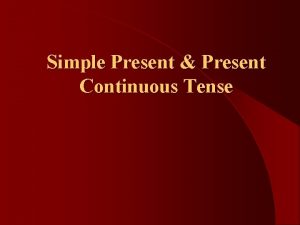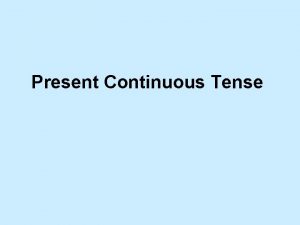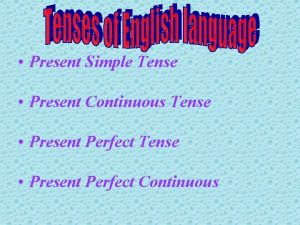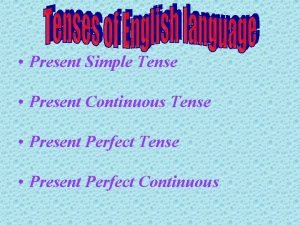PRESENT TENSE PRESENT SIMPLE VS PRESENT CONTINUOUS USE








- Slides: 8

PRESENT TENSE PRESENT SIMPLE VS. PRESENT CONTINUOUS

USE PRESENT SIMPLE PRESENT CONTINUOUS 1. TEMPORARY STATES, 1. PERMANENT STATES, ROUTINE ACTIONS e. g. He works in a software company. 2. GENERAL TRUTH e. g. The sun rises in the east. 3. TIMETABLES, HABITS e. g. We start work at 9 every day. !!!!ANNOYING HABIT→PRESENT CONTINUOUS e. g. You are always interrupting me. 4. SPORTS COMMENTS, INDICATIONS e. g. Hill passes the ball to Dawson. So, ladies, now you mix everything and beat hard. EXCEPTION TO THE RULE ACTIONS e. g. I am working for a software company this month. 2. AN ACTION, A PHENOMENON IN CHANGE e. g. Pollution is growing bigger and bigger. 3. ACTIONS HAPPENING IN THE MOMENT OF SPEECH e. g. Do you mind, I am talking on the phone now! 4. ARRANGED, PLANNED ACTIONS e. g. I am meeting the director today.

STRUCTURE PRESENT SIMPLE PRESENT CONTINUOUS The Infinitive form of the verb for most persons, with the exception of 3 rd person singular. I work, you work, we work, they work. 2 elements: auxiliary verb TO BE + verb + -ing The Infinitive + -s for 3 rd person singular He, she, it sleeps. I am working You are working He (she, it) is working We are working You are working They are working

NEGATIVE FORM PRESENT SIMPLE PRESENT CONTINUOUS Auxiliary verb (DO, DOES) in the negative + verb Negative form of the auxiliary verb TO BE+ verb + -ing I don’t (do not) work. He (she, it) doesn’t (does not) sleep. I am not working. She isn’t (is not) sleeping. They aren’t (are not) working.

INTERROGATIVE FORM PRESENT SIMPLE PRESENT CONTINUOUS Auxiliary verb (DO, DOES) + Subject + verb Auxiliary verb TO BE + Subject + verb+ -ing Do you work? Does he sleep? Are you working today? Is she still sleeping ?

SPECIFIC ADVERBS PRESENT SIMPLE PRESENT CONTINUOUS ALWAYS USUALLY EVERY DAY EVERY WEEK / MONTH / YEAR ON MONDAYS / TUESDAYS… IN THE MORNING / EVENING… REGULARLY OFTEN SELDOM NOW AT THE MOMENT THESE DAYS AT PRESENT NOWADAYS STILL JUST THESE DAYS / MONTH…

GENERAL RULES SPELLING RULES PRESENT SIMPLE: ADDING –S (3 rd person singular) verb + -s : set – sets, get – gets, drop – drops, eat - eats verbs ending in ss, sh, ch, x, o + -es : guess – guesses, blush – blushes, scratch – scratches, fix - fixes, go – goes verbs ending in vowel + y + -s : say – says, play - plays verbs ending in consonant + y + -ies : try – tries, cry – cries, fry – fries 1. PRESENT CONTINUOUS : ADDING -ING verb + -ing : draw – drawing verb ending in –ie turns the ending into y + -ing : die – dying, lie – lying verb ending in -e drops the vowel and adds -ing : make – making, dive – diving verb ending in a stressed vowel + consonant doubles the consonant: put – putting, sit – sitting, cut - cutting

GENERAL RULES 2. OTHER GRAMMAR RULES PRESENT SIMPLE: NEGATIVE FORM, 3 RD PERSON SINGULAR: NO –S FOR THE VERB IN THE NEGATIVE, BECAUSE OF DOESN’T e. g. She doesn’t wakes up at 7. → She doesn’t wake up at 7. PRESENT SIMPLE: INTERROGATIVE FORM, 3 RD PERSON SINGULAR: NO –S FOR THE VERB IN THE INTERROGATIVE, BECAUSE OF DOES e. g. Does she wakes up at 7? → Does she wake up at 7? PRESENT CONTINUOUS: ALWAYS EXPRESS IT WITH 2 ELEMENTS e. g. I working from 8 today, instead of 9. → I am working from 8 today, instead of 9.














